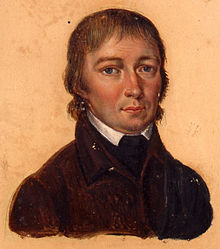Boston’s Civic Festival to honor the new republic of
France on 24 Jan 1793 came at an unusual cultural and political moment.
The latest news from Europe relayed the events of late 1792. Bostonians knew about how the French assembly had deposed
Louis XVI and proclaimed a republic. The French army was pushing back the combined forces of several European monarchies and keeping Britain at bay. It looked like the American model of political liberty and equality was spreading in the Old World.
To be sure, the news included a hint of French Revolutionaries turning on themselves. After trying and failing to preserve the king and constitutional monarchy, the
Marquis de Lafayette (shown here) had fled to
Austrian territory. He was under arrest, viewed by both French republicans and Austrian monarchists with suspicion.
The 26 January
Columbian Centinel showed how Bostonians still admired Lafayette and were following his story. One of the toasts offered at the festival was “Justice to M. LAFAYETTE.” Did that mean justice from France or from Austria? Quite possibly both.
For the most part, however, the people of Boston saw plenty to celebrate. Though Louis XVI’s government did support the U.S. of A. in its fight for independence, Americans had grown up thinking of the French monarchy as an example of tyranny. Now the former king appeared to be in alliance with his fellow despots against his people, so it was easy to hail his downfall. Likewise, New Englanders with their Puritan heritage and established
Calvinism felt little sympathy for the Catholic church in France. The decorations on
Faneuil Hall included “a crown, sceptre, mitre, and chains” being broken under the feet of Liberty.
The festival toasts signaled high hopes for republicanism:
- “The Law—May it always breathe the spirit of liberty and speak the language of patriotism.”
- “Civic virtues to the military, and a military spirit to the citizens.”
- “May the light of philosophy irradiate the caverns of superstition and despotism, and reveal their horrors."
- “In all governments may Liberty be the check, and Equality the balance.”
There were similar but smaller celebrations in other Massachusetts towns.
New Englanders didn’t know that the French government had indicted Louis XVI for treason in December and beheaded him just three days before their festival. Once news of that execution arrived in late March, Americans’ support for the French republic began to fade. Splintering opinion about France was a big part of the development of two semi-organized political parties in the U.S. of A.
In the spring of 1793, some Americans founded what historians later called Democratic-Republican Societies, the basis of what became the Jeffersonian party. On 8 April,
Edmond-Charles Genêt arrived in
Charleston as the new French
minister to America and set about commissioning
privateers to attack British ships. President
George Washington issued a controversial neutrality proclamation on 22 April.
Those developments changed how Bostonians responded to the French Revolution. In January,
as I discussed,
Benjamin Russell’s
Columbian Centinel not only applauded the Civic Festival but referred to local dignitaries and the editor himself with the title “Citizen.” By June, however, that newspaper was firmly Federalist and using that honorific only for officials from France. In his book
Parades and the Politics of the Street, Simon P. Newman wrote that by spring Federalist politicians were conspicuously absent from further celebrations of the French republic.
The
Centinel continued to refer to “Liberty Square” instead of Dock Square for several months, but that term faded away. As for “Equality Lane,” the name appeared almost exclusively in advertising for
John Bryant’s tavern (no longer called “Liberty Hall”). The last reference that I found came in the 23 Aug 1793
American Apollo, in an advertisement for
young acrobats.
After that, “Equality Lane” reverted to being called “Exchange Lane” (no more “Royal”) or “Shrimpton’s Lane” after an early owner of the land. The new name had lasted such a short time that it was never official, never appeared in town directories or on
maps. When historians have mentioned “Equality Lane,” it was always in the way
William Cobbett used it,
as evidence of Boston’s brief infatuation with the French Revolution.
But for a moment in early 1793, Bostonians were calling each other “Citizen” and honoring “Equality” over commercial “Exchange.”





